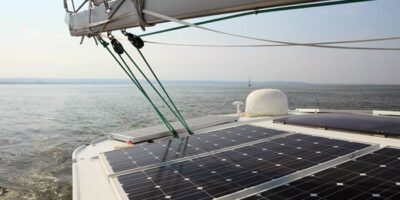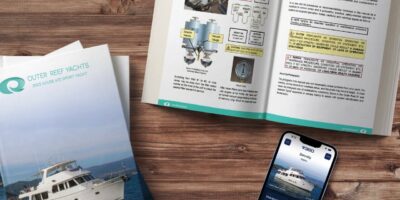Getting Your Vessel Ready Preseason
You may have prepped your boat for winter last year, but here are 14 tips to ensure this boating season will be trouble-free.
- January 15, 2024
You put your boat away for the winter by doing all the right things: changed the oil, winterized the water system and engine, and emptied the boat of all extraneous gear for the offseason. So you might think there’s not much to do come spring except take the cover off, fire up the engine, and head out to the wild blue yonder. Hold on! Not so fast. While there is no doubt that tasks done in the fall speed things up come spring, there are still some things to be addressed before you hit the water.
Things can go wrong on even the best-maintained boats, so it pays to complete a few checks that will both ensure you don’t break down on the water, and your boat and its equipment is safe for you and your family. Even if the marina took care of putting the boat away in the fall, you probably won’t need a mechanic for the jobs on our list. Almost all of the basic actions here can be completed at no cost. You won’t need a ton of tools either, and in many cases, all it takes is a visual check. So what specifically do you need to check?
Bilge Pump & Switch
The best way to make sure your pump and switch are working is to do what Mother Nature would do: add some water to your bilge. You’ll instantly know if all parts of your system are working. If not, check electrical connections at the pump and switch, which are the most common areas for failure. If you’re faced with a trickle outflow, it may be time to upgrade to a larger pump and hoses. See this article to learn more.
Control Cables
Throttle, shift, and steering cables usually slide inside a sheath and it’s hard to see their condition. Grab hold of one and twist it around; if you hear crunchy sounds, chances are there’s rust inside and it’s time to replace. If the cable is just a little stiff, see this article to learn how to lubricate them.
Check out our Spring Fitting Checklist video playlist on YouTube.
Bellows Check
Leaking bellows are one of the most common reasons inboard/outboard (I/O) boats sink at the dock. Even if they looked OK in the fall, carefully inspect them now before your boat goes in the water. Check your bellows with the sterndrive raised and lowered, looking for cracks or sea life such as barnacles and oysters that are sharp enough to tear it open. Many I/O boats also have exhaust and shift cable bellows, so check them as well. If one bellows is bad, they should all be replaced.
Cockpit Drains
Over winter, your cockpit and deck drains may have accumulated a lot of crud, from leaves to dirt to critters. A clogged or slow cockpit drain can sink a boat, especially an older one that might already be squatting lower in the water. Send a high-pressure burst of water from a hose into each drain to make sure it runs free. While you’re checking how fast it drains, inspect the thru-hull fitting as well. Plastic fittings degrade in the sun, and if they crack, they can allow water back into the boat.
Hoses And Thru-Hulls
Speaking of thru-hulls, now is the time to check every one of them before your boat goes in the water. Every fitting below the maximum heeled waterline must have a seacock that can be closed. Over time, seacocks get stiff and may not be able to be closed when you really need them — like when water is gushing into the boat from a split hose. Make sure every seacock opens and closes freely — now’s the time to address the stiff ones, before the boat is launched. While you’re inspecting the thru-hulls, take a look at the hoses and clamps as well. In fact, do more than take a look — give them a firm, twisting tug and make sure the hoses and clamps aren’t past their prime. See see Choosing the Correct Boat Hose to learn more.
Lower Unit
The last thing you want to hear when you take your outboard or I/O boat out for the first cruise of the season is grinding, followed by silence. Lower units can be damaged easily over winter if water trapped inside freezes and expands, causing seals to fail, which can cause the oil to leak out. Worse, water that has frozen can actually crack the housing. Before you even move your boat, check underneath the lower unit and make sure there are no spots of leaking oil. If so, find out what caused it before you launch your boat. Even if you changed the lower unit oil last fall, verify that it’s still topped up. For a video on how to change your lower-unit lube, visit the BoatUS YouTube channel.
Cutless Bearing
If your boat has an inboard engine, grab your prop shaft and vigorously try to move it side to side and up and down. More than just a tiny bit of movement means the bearing needs to be replaced. A worn cutless bearing can cause problems ranging from annoying vibrations to a damaged prop shaft. You can’t replace the cutless bearing while the boat is in the water; if it’s questionable, do it before you launch. See Bad Vibrations to learn more about cutless bearings.
Safety Gear
First, check your required flares — they’re a few months older now and may be expired (flares expire 42 months after the date of manufacture and are marked). Next, locate your fire extinguishers and make sure the pressure gauge is still in the green. Make sure you have enough life jackets and they’re in good shape with no cuts or heavy mildew. If you have sleeping accommodations on a boat with a gas engine or propane stove, make sure there’s a working carbon monoxide larm — most can be tested just like a smoke alarm by pressing the test button. Change batteries if needed. Also, take the opportunity to make a test call on your boat’s VHF or handheld. The U.S. Coast Guard estimates that almost 90% of marine VHF radios are not programmed with an MMSI number — an important safety feature — so do it now. An MMSI number can be obtained via the BoatUS website, free to Members.
Check Fluids
Check the engine, transmission, trim tab oil, and any hydraulic fluids your boat may have. If there’s less in there than when you laid up in the fall, you need to find out why before simply topping up. Hopefully you thought to change the engine oil and filter in the fall, but if not, do it now. See Marine Lubricants to learn more.
Electrical Connections
A faulty electrical connection can leave you stranded on your first day. Make sure your battery cables are tight and free from corrosion. The batteries should have been periodically charged during the winter. If not, charge them now so they’ll start your engine when the time comes. See Marine Battery Maintenance for more.
If you had flickering lights or odd electrical problems last season, your gremlins are probably due to loose wires or connections. Give a tug on your connections to check for tightness. Better to have them come apart now than when you’re on the water. For a video on how to make a perfect electrical connection, go to YouTube.com/BoatUS.
Navigation Equipment
If your boat is equipped with a multifunction display (MFD), power it up to make sure it’s working properly. Check the manufacturer’s website for software and chart updates. It’s often easier to do this when your boat is ashore and you have internet access so you can download the necessary software. Visit Chartplotter Update for a tutorial on how to update some chartplotters.
Anodes
If the anodes on your boat are more than half wasted, they should be replaced. For anodes to work properly, they need to make a good electrical connection. Use some fine sandpaper to clean the mating surface before screwing on the replacement anodes, and remember that they should never be painted. Remember, too, that inboard engines likely have anodes in the heat exchanger and block — they may be small, but they’re vital and often overlooked. For a video on how to replace anodes, go to YouTube.com/BoatUS.
Stuffing Box
Stuffing boxes can’t have their packing easily replaced with the boat in the water. If your stuffing box was leaking more than a couple of drops per minute with the engine running last year, the packing may need to be replaced, or at the very least adjusted. If you’re ready to upgrade, visit our article online at How To Install A Dripless Shaft Seal for step-by-step instructions and a video on how to do it.
Sailboat Rigging
Check standing rigging on sailboats. Were the turnbuckles loosened when you hauled out? Look for corrosion, especially around the chainplates, turnbuckles, and swaged fittings. Put on a rugged pair of gloves and run your hand down the shrouds and stays. If the glove catches on broken strands, the standing rigging needs to be replaced. Visit Inspecting Sailboat Rigging for more on inspecting rigging.
Charles Fort
Contributing Editor, BoatUS Magazine
About Vessel Vanguard
Vessel Vanguard is a leading marine safety and maintenance management software provider dedicated to revolutionizing the maritime industry. With a commitment to innovation and excellence, Vessel Vanguard delivers cutting-edge solutions to streamline operations and enhance vessel performance and safety.
Latest Industry Insights

Embracing E-Boating Efficiencies

Boat Fuel Systems

The Future of Boats & Boating

Yacht Navigation Light Inspection
View All of Our Industry Insights
Navigate maritime with the latest news, practical how-to guides, insightful analyses and more.
